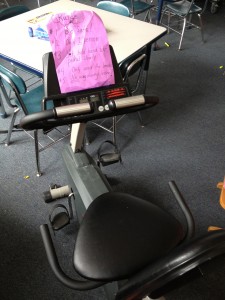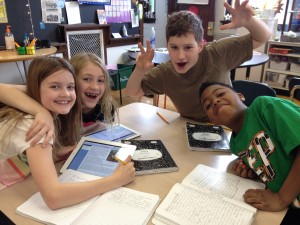Engagement: A Great Start for Critical Thinking!
The Point: When students are authentically engaged, learning is enhanced. There are lots of ways to promote and sustain engagement through the purposeful use of instructional strategies including hands on explorations, interest based inquiry, effective modeling, motion and exercise opportunities, connected technology integration, and the incorporation of learning games in a workshop model.
The Story: Another great week for learning and growth with my partners in BPS! I experienced all kinds of great instruction and collaboration across the grades (and had some fun designing blogs with the wonderful Senior Leibson in the Spanish department). Something that really resonated with me this week is the incredible way my colleagues have been able to keep their students engaged in the learning process. I saw students from Kindergarten to Fifth Grade taking ownership over their learning and stretching their critical thinking capabilities to awesome depths. Here are five examples:
1. These two girls have a box full of stuff. They’re building a machine that will help them explore motion. I walked past them in the hallway a few times as I was in and out of a neighboring classroom working with groups of students on video production. Each time I walked by the girls they were totally wrapped up in the task at hand. One of them was in my class last year and she didn’t even take the time to look up and say, “Hi, Mr. Berg!” When students are so engaged in critical problem solving that they can’t look up to notice their 4th grade teacher walking through the 5th grade hallway, something’s going right!
Sometimes I find myself so distracted by people walking by that I can’t focus on my work. These two didn’t even realize I was there…good stuff. I recently heard of a great idea called “Take It Apart Tuesday.” Just like it sounds, the teacher solicits “junk” from home during the year. Every Tuesday the students spend some time just taking things apart. They get old radios, small pieces of furniture, toys, etc. They explore and discover. The teacher who told me about it also told me that her students count the minutes until it’s upon them each week. Seeing the girls working reminded me that I want to try implementing a “Take It Apart” workshop one of these days. I’m going to check in on next week to see what they discovered.
 2. These 1st and 2nd graders are doing a “See, Think, Wonder” routine. The incredible Ms. Prindle often implements this and other “Visible Thinking” routines when she’s introducing content for her inquiry units. If you look closely you can see the picture on the back wall. It’s a picture of Mars. Everyone, including me, thought that it was the moon. It was great to see the students get excited about what they thought they were seeing, to think about what they knew, to enthusiastically write down information about the moon, and to actively wonder about their curiosities. This age group is particularly exciting when it comes to wondering because they don’t tend to limit themselves when it comes to possibilities.
2. These 1st and 2nd graders are doing a “See, Think, Wonder” routine. The incredible Ms. Prindle often implements this and other “Visible Thinking” routines when she’s introducing content for her inquiry units. If you look closely you can see the picture on the back wall. It’s a picture of Mars. Everyone, including me, thought that it was the moon. It was great to see the students get excited about what they thought they were seeing, to think about what they knew, to enthusiastically write down information about the moon, and to actively wonder about their curiosities. This age group is particularly exciting when it comes to wondering because they don’t tend to limit themselves when it comes to possibilities.
The best part about being in the room during this great lesson was watching Ms. Prindle model the type of enthusiasm she expects from her students. She was excited about letting a visual prompt guide her thinking, she was excited about the moon, she was excited about the potential for learning more, she was excited about having a team of learning partners who would be exploring interesting ideas that she would eventually learn about too, she was excited about outer space, and she used her words and her actions to make all of that excitement clear. It was authentic, it was contagious…it was engaging!
 3. All students get the wiggles, some more than others, and some are better able to focus through them. The brilliant Mrs. Radeky found this old exercise bike and thought that it might help quell some of the more intense wiggles in favor of engagement in learning. I’m happy to report that it seems to be working! The students in her 3rd grade classroom have come to understand the purpose of, and the expectations about using the bike. Those who need it us it, when they need it. Mrs. Radeky has done an incredible job of making clear that her goal is focus for all. The bike is not a toy, it’s not a weight loss device, and it’s not a Tour de France training apparatus…it is a tool for enhanced engagement. Well done!
3. All students get the wiggles, some more than others, and some are better able to focus through them. The brilliant Mrs. Radeky found this old exercise bike and thought that it might help quell some of the more intense wiggles in favor of engagement in learning. I’m happy to report that it seems to be working! The students in her 3rd grade classroom have come to understand the purpose of, and the expectations about using the bike. Those who need it us it, when they need it. Mrs. Radeky has done an incredible job of making clear that her goal is focus for all. The bike is not a toy, it’s not a weight loss device, and it’s not a Tour de France training apparatus…it is a tool for enhanced engagement. Well done!
 4. The 3rd and 4th graders pictured above are super motivated about research and writing. The process that Mrs. Rayle and Mr. Keilmen use is heavily reinforced by modeling and practice with finding and understanding how to process digital information that connects to content and personal interests. These students look forward to digging for information about their topics and translating it into something meaningful, knowing that in the end they will have opportunities to communicate it in creative ways. I really appreciate the intentional use of technology for this purpose. The students are excited about using iPads, laptops, and desktops to explore information. They are fully engaged in collaborating on the transfer of that information, through their writer’s notebooks, and onto their group’s wiki page. The room is steeped in creative energy!
4. The 3rd and 4th graders pictured above are super motivated about research and writing. The process that Mrs. Rayle and Mr. Keilmen use is heavily reinforced by modeling and practice with finding and understanding how to process digital information that connects to content and personal interests. These students look forward to digging for information about their topics and translating it into something meaningful, knowing that in the end they will have opportunities to communicate it in creative ways. I really appreciate the intentional use of technology for this purpose. The students are excited about using iPads, laptops, and desktops to explore information. They are fully engaged in collaborating on the transfer of that information, through their writer’s notebooks, and onto their group’s wiki page. The room is steeped in creative energy!
 5. Fun games are engaging. Fun math games are engaging and they provide students with opportunities to practice critical thinking about math! Mrs. Lindsay and her students have this concept down pat. I was in the room with these 1st graders when a group of them invited me to join in a round of “Top It,” a great game from the “Everyday Math” Program. I noticed two very important things. First, these students were extremely excited about playing a game during their math workshop. They all knew how to set it up and they were thrilled to have an opportunity to teach the new guy (me). Also, the room was functioning like a machine. It was great to see that Mrs. Lindsay’s 1st graders have the workshop structure so engrained in their daily routine that she was able to spend the entire time rotating through small groups, conferring with students, gathering formative data, and delivering individualized instruction. Everyone knew where to go and what to do. The group I was working with was wonderfully engaged in having fun and building critical understandings!
5. Fun games are engaging. Fun math games are engaging and they provide students with opportunities to practice critical thinking about math! Mrs. Lindsay and her students have this concept down pat. I was in the room with these 1st graders when a group of them invited me to join in a round of “Top It,” a great game from the “Everyday Math” Program. I noticed two very important things. First, these students were extremely excited about playing a game during their math workshop. They all knew how to set it up and they were thrilled to have an opportunity to teach the new guy (me). Also, the room was functioning like a machine. It was great to see that Mrs. Lindsay’s 1st graders have the workshop structure so engrained in their daily routine that she was able to spend the entire time rotating through small groups, conferring with students, gathering formative data, and delivering individualized instruction. Everyone knew where to go and what to do. The group I was working with was wonderfully engaged in having fun and building critical understandings!

Kudos to these incredible professionals who are so ingenuously preparing their young students for success in this ever-growing digital world. Dr. Micki